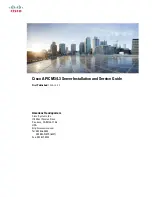
Chapter 10 System Input/Output (I/O) Interfaces
Page 10-2
UNIVERGE
NEAX
2000 IPS
Request for Proposal (RFP) Reference Guide
Issue 6
1400 IMS Format
1400 IMS Format is generally used to print call records on a serial printer and provides an easy to read
format for printouts of outgoing / incoming call activity.
Each record is given a serial number from 0000 to 9999 to identify each call.
Calling Station Number
Called Number (26 digits maximum)
Route Number and Trunk Number
Start of Call Time (from month down to second)
Duration of Call (hours, minutes, seconds, rounded to nearest .5 sec.)
Forced Account / Authorization Code
Account Code
Attendant Handled
Trunk Route Overflow (Route Advance)
CPN/ANI up to (16 digits)
Six options for 80/136 character printers
SMDR Terminal Interface
A Personal Computer or a Host Computer is used as the SMDR terminal for receiving and processing
the call information that arrives at the MP. The transmission interface specification by which the AP or
MP sends out call information to the SMDR terminal are as follows:
SMDR with AP00/MP built-in SMDR on RS-232C
Specifications
ITEM
SMDR w/AP00
MP Built-in SMDR on RS-232C
Physical Interface
RS-232C
RS-232C
Synchronization Asynchronous
Asynchronous
Protocol
Non protocol (Free Wheel)
Non protocol (Free Wheel)
Transmission Speed
1200/2400/4800/9600 bps
(for PN-AP00-B with MRC-C program)
Note 1
300/1200/2400/4800 /9600/19200 bps
(for PN-AP00-B with MRC-F program)
1200/2400/4800/9600/19200 bps
Stop Bit
1/1.5/2 bits
1/2 bits
I/O Port
No. 0-3 port of AP00-B card
RS port of MP card
Terminal Busy
Detecting Method
Data Carrier Detect (DCD) signal
ON/OFF (terminal ready/busy)
Data Carrier Detect (DCD) signal
ON/OFF (terminal ready/busy)
Note 1:
For the port 1 and 3 of AP00-B card with MRC-C program, data speed cannot be set to 9600 bps.
Note 2:
Upon confirming that the status of the DCD signal from the SMDR terminal is ON, the system sends out
call information to the SMDR terminal. When the status of the DCD signal is OFF, the system does not
send out call information but temporarily stores the information until the SMDR terminal becomes ready
to receive call information, in other words, until the status of the DCD signal changes to ON. If the status
of the DCD signal has changed from ON to OFF while transmission of specific call information is in
progress, the next call information is not sent out but stored into the system temporarily. The same
applies to CTS and DSR signals.
Note 3:
For output to MP built-in SMDR, one message is sent at intervals of one second unidirectional.
















































